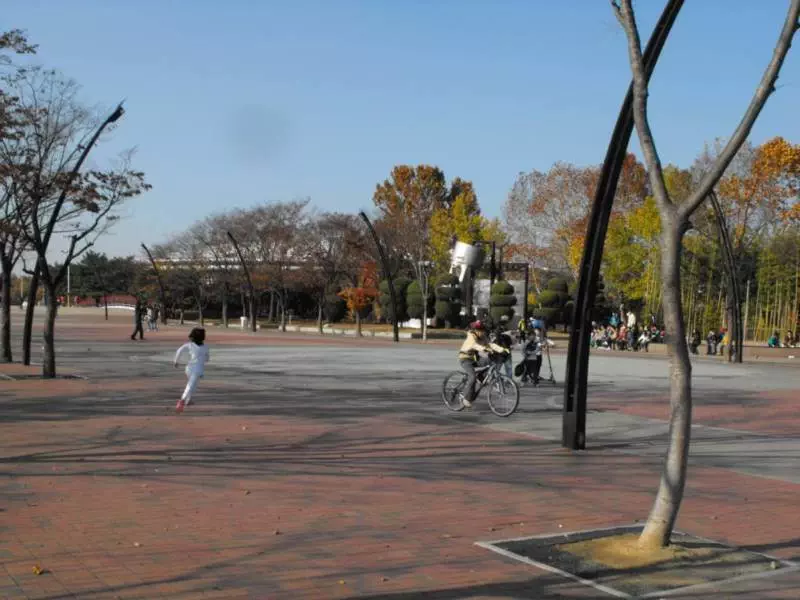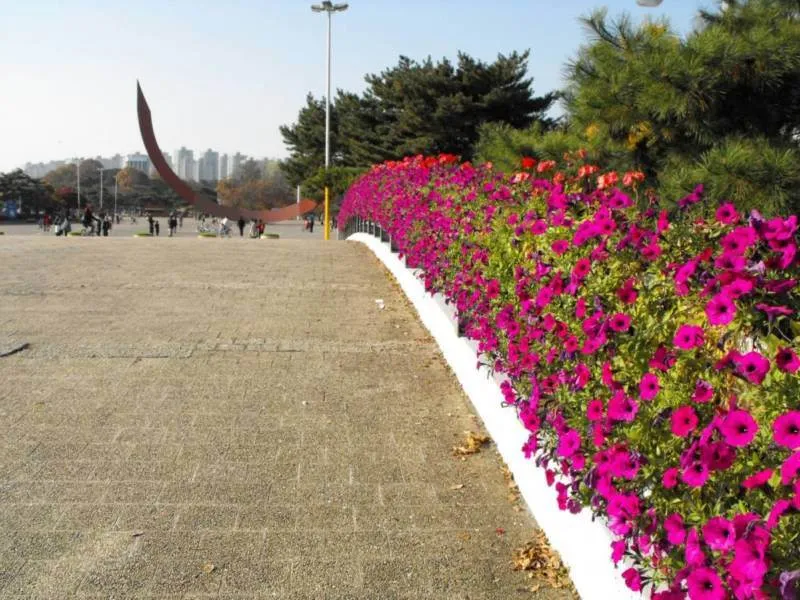
While Olympic Park is where some of the 1988 Summer Olympics took place (the other major area being the previously blogged about Jamsil Sports Complex), the Olympics from 20 years ago seems a legacy, a thing of the past that mostly gets passed by. With 2,000,000 square meters of ‘park’, however, there’s far more than Olympic stadiums to meet the eye.

By the way, just how big is 2,000,000 square meters? Over 21.5 million square feet. Over 494 acres. The size of 8,611 houses (at 2,500 square feet each). In addition to the site’s athletic facilities, there is also an Olympic Museum, several gardens, plenty of public art outdoors (mostly sculptures), an art museum, a Baekje-era fortress (which dates back from before the sixth century), and a World Peace Gate (seen in the first picture of this post). OK, Chris, take a deep breath. You’re not going to see it all. You can’t – there’s just too much. Be OK with that, I told myself. It’s definitely not possible to see it all in one day.
On the positive side, it was quite possible to enjoy a beautiful mid-November autumn with the leaves displaying their vibrant shades of red, orange, and yellow. For the first time, I worried less about seeing it all than simply seeing what there was to see. It’s too easy to get off-target, as though there’s a checklist of things you simply MUST see when you visit somewhere. That’s not the case at all, except for that poor tourist who simply insists he hasn’t seen everything there is to see. In any case, the goal was to enjoy the day, take some representative pictures, and to not worry about what I didn’t get to see.
Coming from the subway, my friend Charlotte and I began exploring some of the public art – interesting, although not always readily understandable.

Entitled “Din;Ding-Dang-Dong” by Nigel Helyer of Austraila. Four incredibly huge crucibles / bells hung a few centimeters off the ground, and “are iconographically keyed to…the historical Korean tradition of the ‘Heaven Bell’.” Um, sure – big crucible / bell things are always fun. They were more than sturdy enough to strike, and they produced some interesting sounds as a result.

Entitled “What Falls is Flying” by Kang Eun-Yup of Korea. According to the artist, “this sculpture was an experiment to try to depict the relationship of contradictory elements such as the transparent glass symbolizing the psyche, [and] the rusted metal symbolizing the material world, the soul and the physical body…”
OK, enough art for now – time to move on.

Crossing a bridge into a large area – note how small the people are in the background.

Flowers make some of the best macro shots ever – hope you like 🙂

Entitled “Relatum-by Omen” by Lee U-Fan of Korea, this maze of rusted steel plates and natural rocks was one of my favorite works of art in the park. That it was fun to climb on was really the best part. According to the artist, “The harmony of undefined opposites, myself, stones, and steel plates…will create an inexplicable mysterious world before us.”
After some lunch, we walked around some more, eventually finding a wonderfully open field:

Any number of badminton games, soccer balls getting kicked around, baseballs being thrown, and so on and so forth. Thanks to having so much area, we could literally walk through the middle of the field and not interfere with anyone else.

Walking between two hills into another very open field – this one more full of fall colors and a bit less crowded.

(If you’re enjoying these photos, don’t forget to click on them to get a full-sized version. Right-click, then click “Save Target As…” or “Save Photo As…’, depending on your browser. Alternatively, click on “Set as Desktop Background” to make it your new desktop wallpaper.)
Before long we came across what must have been the sculpture park:


Entitled “Muscles and Snow” by Minujin Marta of Argentina, the figure seemed to depict a sort of headless creature to me personally.

Almost like a giant seesaw, the two ends of this apparatus somewhat balanced on the mid-point, although the side that was down was slightly heavier.

Even more sculptures were there to see, but we moved on into one of the Olympic areas near the entrance.

Approaching one of the bigger entrances of Olympic Park. Remember – 2,000,000 square meters? There’s bound to be more than one place to enter or exit.

The records and flags from the 1988 Olympics, displayed in stone for all time. Whatever you do, don’t make a typo if you’re the carver!

While there are several gigantic buildings which once held the world’s attention, they are mainly not open to the public. These include the Olympic swimming pool, the Veliodome (bike racing track), and multiple gymnasiums. Part of me wonders what they could do or are doing with them 20 years after the fact… From the outside they still look impressive – and I’m sure some wonderful events could be held there if they wanted.

No park of any size can possibly be called a park without having a playground for the kids – or, um, two American teachers who act like kids 🙂

A couple parting shots of the beautiful area.
Ready for more? Read part 2 and part 3 of Olympic Park.
On the Seoul subway system, take line 5 towards Macheon and get off at the Olympic Park subway station. Take exit 3 to street level. Enjoy walking.



Fabulous photos!